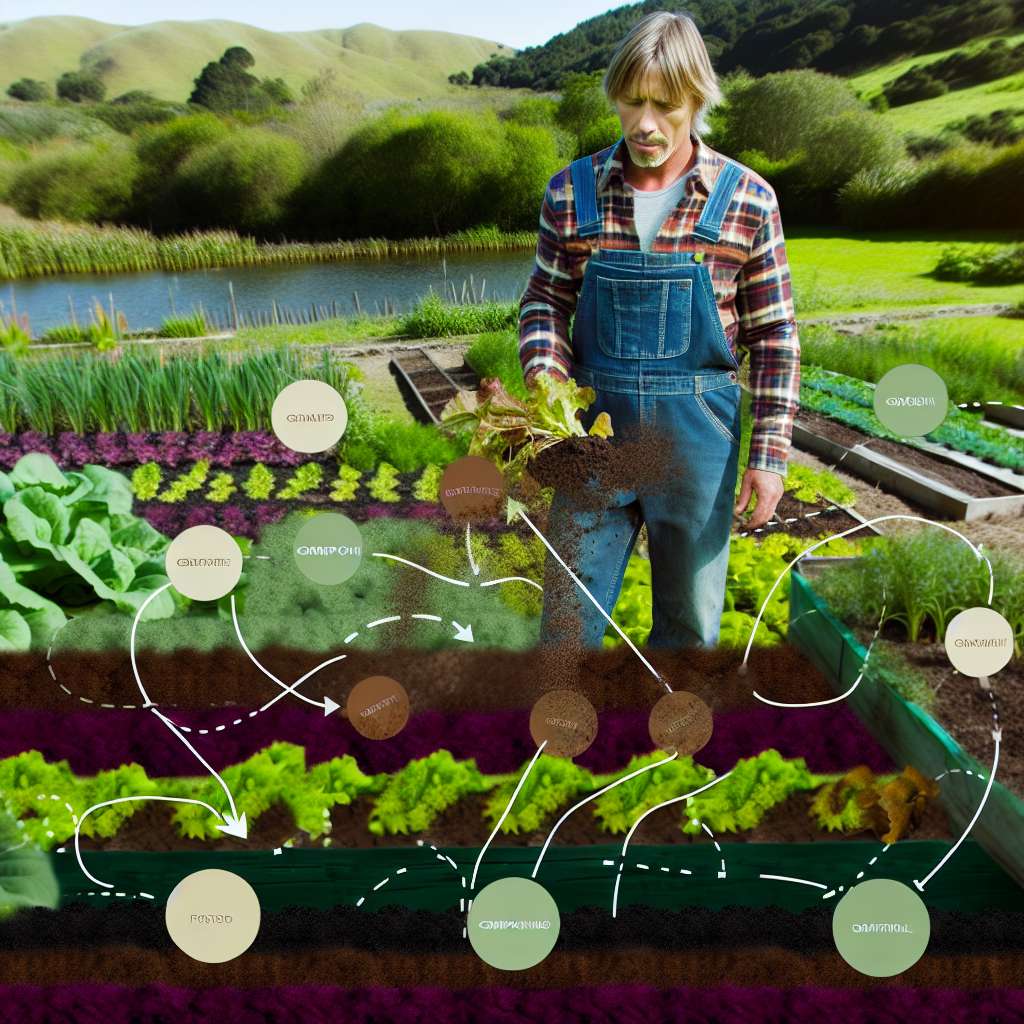Understanding the Principles of Permaculture in Small Farming
Core Ethics of Permaculture
Permaculture is guided by three core ethics: care for the earth, care for people, and fair share.
These principles shape sustainable practices in small farming systems.
By prioritizing these ethics, farmers create resilient ecosystems.
Designing with Nature
Permaculture emphasizes working with nature rather than against it.
Farmers should observe natural patterns in their environment.
Utilizing these patterns leads to more efficient resource use.
For instance, planting trees can provide shade for crops.
This improves crop yield while conserving water.
Diversity and Resilience
Diversity is crucial in permaculture systems.
Growing a variety of plants enhances ecosystem resilience.
Diverse crops reduce pest outbreaks and disease spread.
Additionally, this approach ensures a more stable food supply.
Soil Health and Management
Healthy soil forms the foundation of permaculture practices.
Farmers should focus on building soil fertility.
This includes practices such as mulching and composting.
Transform Your Agribusiness
Unlock your farm's potential with expert advice tailored to your needs. Get actionable steps that drive real results.
Get StartedThese techniques enrich the soil and retain moisture.
Water Management
Efficient water use is essential in small farms.
Permaculture techniques promote natural water flow management.
Implementing swales can capture and direct rainwater efficiently.
These earthworks enhance water retention and reduce erosion.
Community and Collaboration
Permaculture encourages collaboration with the local community.
Small farmers can share resources and knowledge for mutual benefit.
Community gardens and cooperative initiatives can thrive under these principles.
Such collaborations enhance food security and resilience.
Soil Health Management
Importance of Healthy Soil
Healthy soil supports robust plant growth and yields.
It contributes essential nutrients and supports beneficial microorganisms.
Moreover, healthy soil promotes water retention and reduces erosion.
Composting Techniques
Composting enriches soil and recycles organic matter.
Begin by collecting kitchen scraps and yard waste.
Then, layer brown materials, like leaves, and green materials, such as grass clippings.
Maintain moisture and aerate the pile regularly.
In a few months, you will have nutrient-rich compost.
Crop Rotation Practices
Crop rotation prevents nutrient depletion and pest buildup.
Plan to rotate crops each season to different areas.
Include legumes to naturally fix nitrogen in the soil.
This enriches the soil for the next year’s crops.
Cover Cropping Advantages
Cover crops protect soil between main cropping seasons.
They enhance soil structure and improve nutrient availability.
Additionally, cover crops suppress weeds and reduce erosion.
Showcase Your Farming Business
Publish your professional farming services profile on our blog for a one-time fee of $200 and reach a dedicated audience of farmers and agribusiness owners.
Publish Your ProfileChoose species like clover or rye for effective cover crops.
Mulching for Soil Protection
Using mulch helps retain soil moisture and temperature.
Organic mulches, like straw or wood chips, offer additional benefits.
They decompose slowly, adding nutrients back into the soil.
Additionally, mulch suppresses weed growth, reducing maintenance.
Utilizing Natural Amendments
Add natural amendments to boost soil fertility.
Consider using materials like bone meal, wood ash, and rock phosphate.
Each amendment provides specific nutrients tailored to plant requirements.
Regular testing will help you determine the needs of your soil.
Maintaining Soil Structure
Soil structure is vital for water drainage and root penetration.
Avoid excessive tilling, as it can harm soil aeration.
Instead, practice no-till farming techniques when possible.
These practices encourage the development of a healthy soil biome.
Integrating Organic Practices
Organic practices bolster soil health and biodiversity.
Use organic fertilizers and pest control methods to minimize chemical use.
Moreover, planting diverse crops promotes beneficial insect populations.
This creates a balanced ecosystem within the garden or farm.
Water Conservation Strategies
Importance of Water Efficiency
Water conservation plays a crucial role in permaculture gardening.
Efficient water use enhances soil health and plant growth.
Furthermore, it reduces water stress during dry spells.
Designing Efficient Irrigation Systems
A well-designed irrigation system saves water and time.
Consider drip irrigation for its efficiency in delivering water.
This method applies water directly to the soil, minimizing evaporation.
Additionally, it targets plant roots, encouraging deeper growth.
Rainwater Harvesting Techniques
Collecting rainwater is an effective conservation strategy.
Install rain barrels to store water from rooftops.
This water can irrigate gardens during dry periods.
Moreover, it reduces reliance on municipal water sources.
Soil Moisture Management
Soil health directly affects water retention capacity.
Add organic matter like compost to improve soil structure.
This enhances moisture retention and encourages beneficial microbes.
Cover crops also help keep soil moist and reduce erosion.
Mulching for Water Retention
Using mulch is an excellent way to conserve moisture.
It reduces evaporation from the soil surface significantly.
Organic mulches also improve soil texture as they decompose.
Furthermore, they suppress weeds that compete for water.
Microclimate Creation
Creating microclimates helps optimize water usage.
Plant trees or shrubs to provide shade for delicate crops.
This can reduce water evaporation and temperature extremes.
Moreover, it fosters a diverse ecosystem around your garden.
Showcase Your Farming Business
Publish your professional farming services profile on our blog for a one-time fee of $200 and reach a dedicated audience of farmers and agribusiness owners.
Publish Your ProfileMonitoring and Adjusting Water Use
Regularly monitor your irrigation practices for efficiency.
Use soil moisture sensors to determine when to water.
Adjust your schedule based on current weather conditions.
This proactive approach prevents overwatering and waste.
Explore Further: How Companion Planting Supports Sustainable Agriculture
Plant Companioning: Maximizing Yields through Plant Relationships
Understanding Plant Companioning
Plant companioning involves growing different plants together for mutual benefits.
This practice enhances crop yields by improving growth conditions.
Furthermore, certain plants can deter pests and diseases.
Benefits of Companion Planting
Companion planting offers several ecological advantages.
- Improves soil fertility through nitrogen-fixing plants like clover.
- Reduces pest populations naturally with aromatic herbs like basil.
- Enhances pollination with flowers that attract beneficial insects.
Effective Plant Pairings
Choosing the right plant combinations is crucial for success.
For instance, tomatoes thrive when planted with basil.
Additionally, carrots grow well alongside onions to repel pests.
Moreover, corn provides support for climbing beans while benefiting from their nitrogen.
Tips for Successful Companion Planting
Begin by researching compatible plants for your garden.
Plant in diverse clusters rather than neat rows to maximize space.
Rotate crops annually to prevent soil depletion and disease buildup.
Regularly monitor the garden for signs of pest problems.
Finally, adjust your plant pairings based on performance over time.
Find Out More: Vertical Farming for Growing Fresh Produce Year-Round
Integrating Animals into Permaculture Systems
Benefits of Integrating Animals
Integrating animals into permaculture systems offers numerous benefits.
First, animals contribute to waste reduction by consuming kitchen scraps.
They also help control pests naturally, enhancing overall ecosystem health.
Additionally, animal manure enriches soil, promoting plant growth.
Furthermore, grazing animals can manage grasslands, reducing fire hazards.
This synergy supports biodiversity, creating a balanced environment.
Techniques for Successful Integration
Implementing animals in permaculture requires careful planning and techniques.
One method involves using rotational grazing to optimize forage use.
This method prevents overgrazing while allowing grasses to recover.
Another technique is combining different species to promote complementarity.
For instance, chickens clean up after larger livestock while also providing eggs.
Designing Animal-Friendly Spaces
Designing spaces that accommodate animals is crucial for success.
Start by integrating animal shelters that provide comfort and protection.
Ensure water sources are easily accessible and clean.
Additionally, create fencing to keep animals safe and contained.
Employ companion planting to provide shade and enhance biodiversity.
Choosing the Right Animals
Selecting appropriate animal species is vital for success.
Poultry, such as chickens and ducks, are excellent for small spaces.
Goats are great for brush clearing and provide beneficial manure.
Rabbits also offer meat and can help with garden pest control.
Each species brings unique benefits to the permaculture system.
Showcase Your Farming Business
Publish your professional farming services profile on our blog for a one-time fee of $200 and reach a dedicated audience of farmers and agribusiness owners.
Publish Your ProfileFind Out More: Small Livestock Management for Diversified Income Streams on Farms

Creating Microclimates: Utilizing Natural Features for Optimal Growth
Understanding Microclimates
Microclimates are localized climatic conditions differing from the surrounding area.
They can influence plant growth and overall farm productivity significantly.
Understanding your land’s natural features is key to creating effective microclimates.
Identifying Natural Features
Observe the topography of your land carefully.
Hills, valleys, and slopes create distinct microclimates.
Next, assess tree lines or existing vegetation that provide shade and windbreaks.
These features influence temperature, humidity, and sunlight exposure for your crops.
Implementing Microclimates
Start by planting trees strategically to create shade zones.
These zones reduce temperature and conserve moisture in adjacent areas.
Likewise, utilize rocks or walls to redirect wind, further stabilizing microclimate conditions.
In addition, plant ground cover crops to enhance soil moisture retention.
Utilizing Water Features
Ponds and streams can significantly affect local temperature and humidity.
Position crops nearby to benefit from the moderated climate these features provide.
Water bodies also attract beneficial wildlife, aiding pollination and pest control.
Monitoring and Adjusting
Regularly monitor your microclimate conditions to assess their effectiveness.
Take note of temperature fluctuations, humidity levels, and plant health.
Make adjustments as needed to improve or expand your microclimate strategies.
This proactive approach promotes optimal growth and sustainability on your small farm.
Gain More Insights: Greenhouse Farming for Starting a Commercial Business
Utilizing Vertical Gardening
Maximizing Space in Small Areas
Vertical gardening offers an innovative solution to space limitations.
It allows you to grow more crops in confined spaces.
Additionally, it enhances the aesthetics of your small farm.
Consider using walls, trellises, and containers for your vertical garden.
Choosing the Right Plants
Opt for climbing plants that thrive in vertical spaces.
Beans, peas, and cucumbers are excellent choices.
Moreover, many herbs, such as basil and mint, can also grow vertically.
Using native plants can increase biodiversity in your garden.
Implementing Trellises and Supports
Trellises provide a sturdy structure for climbing plants.
They come in various materials such as wood or metal.
Ensure your trellis is tall enough for the plants to grow fully.
Furthermore, consider adding netting for additional support.
Utilizing Hanging Gardens
Hanging gardens are a creative way to utilize unused vertical space.
Consider using pots, planters, or repurposed materials for a unique look.
Hanging plants can also improve air circulation for better health.
Make sure to select plants appropriate for hanging gardens.
Employing Container Gardening
Container gardening offers flexibility for small farm spaces.
Choose various container sizes to cater to your gardening needs.
Use containers with excellent drainage to support plant health.
You can move containers around for optimal sunlight exposure.
Showcase Your Farming Business
Publish your professional farming services profile on our blog for a one-time fee of $200 and reach a dedicated audience of farmers and agribusiness owners.
Publish Your ProfileCreating Microclimates
Vertical gardens can create unique microclimates for plants.
Use walls and structures to provide shade and protection from wind.
This can help with temperature regulation and moisture retention.
Additionally, consider integrating water-efficient systems to enhance growth.
Crop Rotation and Diversity: Enhancing Resilience in Small Farms
The Importance of Crop Rotation
Crop rotation involves changing the type of crops grown in a specific area each season.
This technique improves soil health by preventing nutrient depletion.
Additionally, it reduces pest and disease pressure.
Farmers can alternate nitrogen-fixing plants with nutrient-hungry crops.
This practice naturally enriches soil while promoting biodiversity.
Implementing Crop Rotation
Start by planning a diverse crop schedule for the growing season.
Identify which crops are most effective for rotation in your area.
For example, rotate legumes with leafy greens or root vegetables.
Schedule the planting based on each crop’s growth cycle.
Maintain detailed records to track crop performance and soil conditions.
Benefits of Crop Diversity
Crop diversity can enhance resilience against climate variability.
When farmers plant different crop species, they reduce risks associated with monocultures.
Moreover, diverse crops attract various beneficial insects, aiding pollination.
These insects can naturally control pests, decreasing reliance on chemical inputs.
Creating a Diverse Ecosystem
Establish buffer zones with wildflowers, shrubs, and native plants.
These areas support beneficial wildlife and improve ecosystem health.
Incorporate cover crops during the off-season to protect soil structure.
Consider intercropping, where two or more crops grow together for mutual benefits.
This strategy can optimize space and resource usage effectively.
Monitoring and Adapting Practices
Regularly assess the effectiveness of your rotation and diversity strategies.
Use soil testing to track nutrient levels and health over time.
Gather data on pest populations and plant health throughout the seasons.
Be prepared to adapt your practices based on observations and results.
Continuous learning helps ensure long-term sustainability and productivity.
Additional Resources
What is Syntropic Farming?: A Permaculture Perspective — Porvenir …




